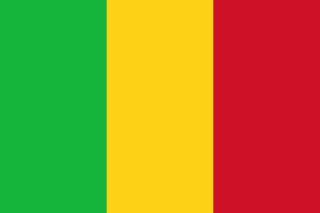
Ivory Coast invested remarkably in its transport system. Transport Infrastructures are much more developed than they are other West African countries despite a crisis that restrained their maintenance and development. Since its independence in 1960, Ivory Coast put an emphasis on increasing and modernizing the transport network for human as well as for goods. Major infrastructures of diverse nature were built including railways, roads, waterways, and airports. In spite of the crisis, neighbor countries still strongly depend on the Ivorian transport network for importing, exporting, and transiting their immigrants to Ivory Coast.

Bamako is the capital and largest city of Mali, with a 2009 population of 1,810,366 and an estimated 2022 population of 2.81 million. It is located on the Niger River, near the rapids that divide the upper and middle Niger valleys in the southwestern part of the country.

Kayes is a city in western Mali on the Sénégal River with a population of 127,368 at the 2009 census. Kayes is the capital of the administrative region of the same name. The name "Kayes" comes from the Soninké word "karré", which describes a low humid place that floods in rainy season. The city is located 420 kilometres (260 mi) northwest of the capital Bamako.

Kati is an urban commune and the largest town in Mali's Koulikoro Region. The town is situated 15 km northwest of Bamako, Mali's capital, on the Dakar-Niger Railway. In the 2009 census, the commune had a population of 114,983.

Air Sénégal International was an airline with its head office in Dakar, Senegal. It was a regional carrier operating a scheduled domestic network and regional flights to neighbouring countries. It also operated charter and air taxi flights. Its main base was Dakar-Yoff-Léopold Sédar Senghor International Airport.
Trans Air Benin — national air transport company, operating regular and irregular passenger.
Slok Air International (Gambia) Ltd was a scheduled passenger airline registered in Gambia. Its main base was at Banjul International Airport in Banjul, the Gambia.

Koulikoro is a town and urban commune in Mali. The capital of the Koulikoro Region, Koulikoro is located on banks of the Niger River, 59 kilometres (37 mi) downstream from Mali's capital Bamako.

The Dakar–Niger Railway connects Dakar, Senegal to Koulikoro, Mali. The name refers to the Niger River, not the Republic of Niger. It serves many cities in Senegal, including Thiès, and in Mali, including Kayes, Kita, Kati, Bamako. The line covers a course of 1,287 km of which 641 km lies in Mali. The line is managed by the Transrail consortium.

Articles related to Mali include:

The Trans–West African Coastal Highway or TAH 7 is a transnational highway project to link 12 West African coastal nations, from Mauritania in the north-west of the region to Nigeria in the east, with feeder roads already existing to two landlocked countries, Mali and Burkina Faso.

The Trans-Sahelian Highway or TAH 5 is a transnational highway project to pave, improve and ease border formalities on a highway route through the southern fringes of the Sahel region in West Africa between Dakar, Senegal in the west and Ndjamena, Chad, in the east. Alternative names for the highway are the Dakar-Ndjamena Highway or Ndjamena-Dakar Highway and it is Trans-African Highway 5 in the Trans-African Highway network.

The following outline is provided as an overview of and topical guide to Mali:
The West African Club Championship, also known as the General Eyadéma Cup, was a West African Club tournament from 1977 to 1999. It was open to league runners-up in the West Africa region of the CAF. While the first matches were played of the 2000 tournament, the competition was cancelled before the final, largely for financial reasons. While the intention of the CAF was to revive a national squad tournament in its place, the planned annual CSSA Nations Cup has not been regularly scheduled since. The tournament was resurrected in 2009 to pit each member country's highest team not featuring in the CAF Champions League or the CAF Confederation Cup. The final four was played in December with Togo as the host.
Railway stations in Mali include:
Mali has one railroad, including 729 kilometers in Mali, which runs from the port of Koulikoro via Bamako to the border with Senegal and continues on to Dakar. The Bamako-Dakar line, which has been described as dilapidated, was owned by a joint company established by Mali and Senegal in 1995, with the eventual goal of privatization. In 2003 the two countries sold a 25-year concession to run the rail line to a Canadian company, which has pledged to upgrade equipment and infrastructure.

The West Africa Regional Rail Integration is a proposal to connect up isolated railway networks in West Africa.
Atlantic Bank Group, commonly known by its French name Groupe Banque Atlantique, is a West African financial services conglomerate, headquartered in Lome, Togo. The Group consisting of banks and other financial services companies in Cote d'Ivoire, Benin, Niger, Burkina Faso, Mali, Togo, Senegal and Cameroon.
Sky Mali,, is a private airline operating in Mali. It serves local destinations, from its operations base at Modibo Keita International Airport, near Bamako, the Malian capital city.














